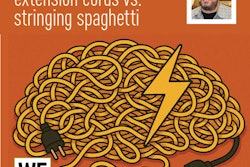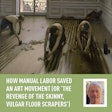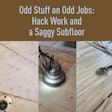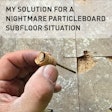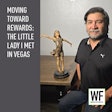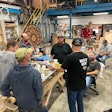Hello, Keith Long here with Thunderheart Flooring to address a question posed by a fellow contractor about my start in real estate investment.
While I write these blog posts, one of the concerns at the forefront of my mind is to put out information about what I’ve done, both technically in hardwood flooring and in business, that may be of value to others. Those of you reading can then determine what value that information has or doesn’t have concerning your business.
I don’t mean to come across as a person who has always had it together. The “school of hard knocks” taught me a few lessons. In my youth, I wanted to buy up the whole county, be a real mover and shaker. I invested as a silent partner in a laundromat, thinking I could get return on investment without having to do anything. The returns were not anywhere near what had been projected, and I sold my interest for about half of what I had bought it for. Next, I put a good chunk in an investment that went to zero.
The returns were not anywhere near what had been projected, and I sold my interest for about half of what I had bought it for.
These things I did when I was younger would have been given little or no consideration by my mentors. Once I started paying attention to what their criteria was for where they put their investment dollars, and did as they did, I began to build wealth.
Here are the parameters I used concerning investment property:
1. I set a goal about how much property was needed for retirement.
I calculated how much money I would need to have coming in from investment properties to, at a minimum, replicate the income I made working. Then, I broke that down into how many rental units were needed, and at what rents versus expense, it would take to truly replace my income so that I didn’t have to work if I didn’t want to.
2. I set parameters for what was an acceptable return on investment.
Real estate prices vary in different parts of the country, as do the rents that investment properties bring in. I’ve found Colorado to be a place many people want to live. Rents have been relatively strong for quite some time. Yet, housing prices aren’t as high here as in some parts of the country. This can potentially provide great returns. I set a goal of purchasing five rental properties over the course of 10 years. I also set the parameter that after downpayment, closing costs and fix-up costs were paid out of pocket, the rents coming in from the investment property had to pay off the mortgage in 10 years or less. These properties are out there—if a person is patient, and keeps a close eye on the market, they can be acquired.
3. I patiently built up my investment account funds until the right properties came along at the right prices to meet my criteria for location and return on investment. When the opportunities presented themselves, I was ready, and acquired them.
It took me a while to warm up to the point where I was confident enough to actually purchase my first investment property. I was a full-time real estate agent for five years before getting into hardwood flooring. There was one particular client I was helping to purchase homes. This gentleman would buy foreclosed homes, fix them up, and sell them for a profit. He inquired as to when I was going to get into real estate investing myself. I told him I was interested but wanted to buy and hold rental property for retirement, instead of fix and flip.
He and I formed an LLC (limited liability company) and bought a duplex together. It was a foreclosed property. At the closing table, when all the paperwork was done, the closing agent for the title company said, “Congratulations—you two are now the proud owners of a crappy duplex in a mediocre neighborhood!” One side was almost ready to be rented when we purchased it, so we focused on getting it fixed first.
“Congratulations—you two are now the proud owners of a crappy duplex in a mediocre neighborhood!”
My partner was a real stickler for paperwork, as am I. He told me, “We’re going to kiss a lot of frogs before we find our prince. Let’s be patient, and wait for as long as it takes to find the right tenants to rent to.” That’s a piece of advice I’ve followed ever since with real estate investing, with great results.
The other side of this duplex needed lots more work to get it back to a respectable condition. We worked on it nights and weekends for about five weeks to get it back up to par. Then, we patiently waited for the right tenant to apply. We drew up a lease with her, and all these years later, she still rents there today!
My partner from back then wanted to continue to fix and flip homes, and I wanted to buy and hold. So, I bought his interest in this duplex, which freed up his capital to continue to fix and flip. I kept this duplex, which I still own today. Since, I’ve bought the rest of the rental properties in my portfolio without partners. I really appreciate how this gentleman guided me through the process on this first one. He had been down this road before, and helped me avoid reinventing the wheel and making costly mistakes.
Building on an idea previously mentioned (in my posts My Business Philosophy At 40, Part 1 and Part 2), I was setting aside 10 percent of my income for investment. When I first became aware this concept, I was shoeing horses for a living. I had just finished reading The Richest Man In Babylon by George S. Clason and set out the next day to work. I shod two saddle horses at a feedlot, and was paid $140 for my efforts.
I went to the bank on the way home, and informed them that I’d like to open a separate savings account, dedicated solely for investment. When asked how much I wanted to deposit, I told them $14 (since that was 10 percent of my income for that first day). The teller laughed, and informed me I needed more than that to start a savings account at that bank. I thanked her for the information, and turned to leave. As I was heading out the door, she asked me what I was planning to do with my savings. I told her it wasn’t any of that bank’s concern—I didn’t fit into their mold, and that was all I needed to know. I got with another bank that sat down with me and asked questions about what my goals were in opening a savings account dedicated solely for investment. In due time, they serviced a couple loans when I was ready to purchase real estate for investment.
4. I manage my own properties.
I grew up around people with very little patience for incompetence. One of my mentors went into the Army after school. He told me that at one point in his military career, the commanding officer instructed them where to be dressed and standing in formation the next morning at 7 a.m.. Most of them were, but a few came straggling in late. The commanding officer ordered those that were late onto a bus, which drove away. He then said, “That bus is heading to a plane that will take a flight tonight for Korea. I am not the kind of man that is going to ask, ‘Why were you late?’ That is not my job. It is my job to command. It is your job to do as I say.”
Although extreme, my reasoning for recalling this story is threefold. I believe that for one, most successful people are organized. Two, they can take direction. Three, they understand the concept of cause and effect.
No one is more interested in my holdings being successful than I am. I tend to my rental property interests personally, because I believe I can do the job with the highest level of responsibility, and at the lowest overall cost. Even with quite a few units, I have the time it takes to manage and maintain them, while doing floors on a regular basis.
5. Once investment properties are free and clear, I reinvest 100% of the profits.
This is another of the core principles of the book The Richest Man In Babylon.
Once I understood the framework to financial freedom, it has been a relatively straightforward process to plug into and succeed. I set aside at least 10 percent of my income for investment, and keep my eyes peeled and ears open for investment properties that meet my criteria. When I find one that meets the parameters I have set, and I can afford it, I acquire it, with the intention of holding it forever.
Once I got some of the investment properties mortgage-free, that’s when my efforts toward retirement started gaining momentum at a faster clip. I read a quote by Albert Einstein that said, “Compound interest is the eighth wonder of the world. He who understands it, earns it. He who doesn’t, pays it.”
During my journey toward retirement, I would imagine walking out to the mailbox on the first of the month, and having several rent checks there, with only a small percentage of this income having to go out for taxes, insurance, utilities, and upkeep and maintenance. It’s a great feeling to arrive at that place. It takes so much pressure off a person. It gives a person options.
I have a suspicion that for some, a blog post of this nature is about as exciting as watching paint dry. I also suspect that for a few, these examples of what I’ve done could be the spark that could help start a fire to warm up some retirement plans. Either way, I wish all of you success.
I intend for my next post to be about integrity in business.
Stay sharp!















